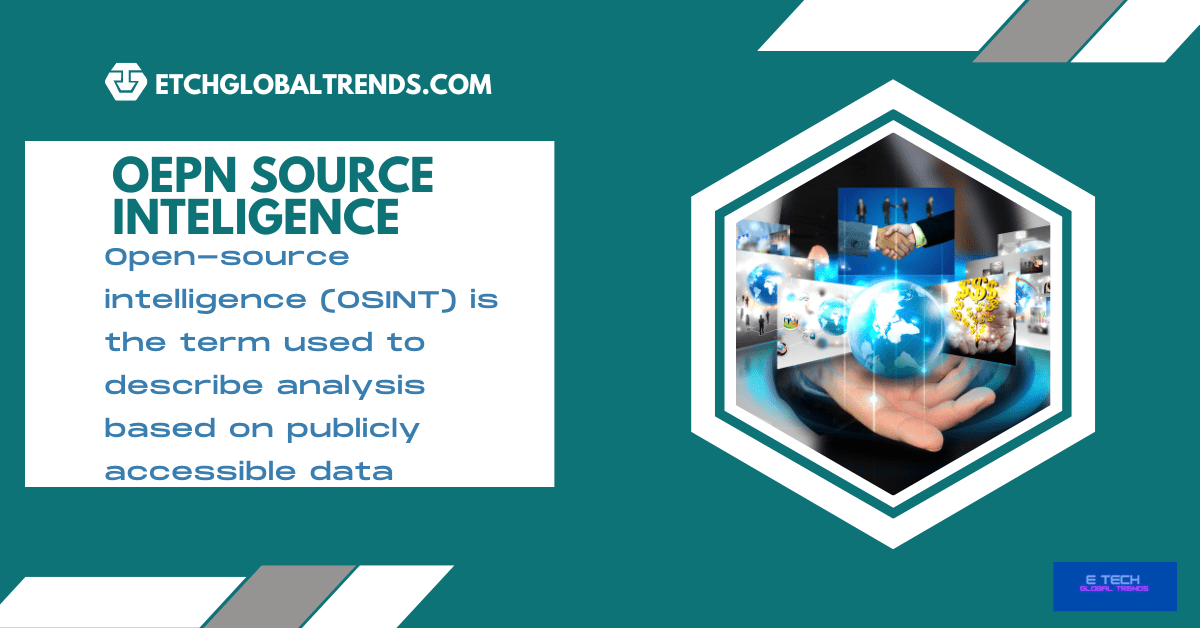open source intelligence
Over the past 5 years, “business intelligence” searches have grown by 166%. About 26% of businesses use business intelligence as part of their strategy. Open-source intelligence (OSINT) is the term using to describe analysis based on publicly accessible data. Although the concept of OSINT has been there since the Cold War. It has recently gained popularity again due to machine learning methods that allow the processing & analysis of data at a large scale.
Open-source information is becoming more and more common among corporations in a variety of fields, including cybersecurity.
Well, shall we read some insights on OCINT?
Stay tuned, until the end.
Where are they trending?
Specifically,
- external threat detection
- penetration testing
- ethical hacking
Additionally, the prediction is, the OSINT market would increase 4 times over the next 5 years. indicating a huge opportunity for companies in this industry.
The meta trend of open-source business intelligence includes open-source intelligence.
What does “Open-Source Intelligence” mean?
Open-source intelligence (OSINT) is information gathered from freely accessible sources for use in intelligence-related contexts.
This includes information obtained through;
- websites
- social media platforms
- news organizations
- other open sources.
The increased accessibility of data as well as the creation of new instruments for gathering and analyzing. causing the OSINT approach to advance recently.
Because they offer a means of gathering and analyzing data from a number of sources, OSINT technologies are crucial for intelligence analysts, as well.
However, the cost is the main deterrent for SMBs from using business intelligence solutions.
For this reason, many businesses are using open-source business data & solutions for business intelligence requirements.
Popular open-source BI tools include;
- Power BI
- Rapid Miner
- KNIME
What is Open AI?
Open-source intelligence is the full name of this term. Its task is to collect data from the Internet. With open-source intelligence, it is permissible to lawfully gather information from online public sources about any individual or organization. By carefully examining cybercrimes and getting crucial information from them, open-source intelligence gathers all the information on different companies and cybercriminals. The primary goal of open source intelligence is really to compile data on hackers from all over the internet and utilize artificial intelligence to track them down.
Therefore, each coin contains two sides, of which one is good and the other is bad.
On the bright side, it is utilized by the government, large corporations, and white-hat hackers to obtain data from online offenders.
In an incorrect sense, hackers employ similar techniques in a reverse way, obtaining data from a company or all people, which is referred to as a cyberattack.
The open-source intelligence framework’s job is to collect data from unpaid tools and sources.
How does OSINT (open-source intelligence) work?
In its most basic form, you’ll discover that many individuals utilize different forms of open-source intelligence almost daily.
An excellent illustration is when a person looks up certain things they are seeking to purchase to see what recommendations they have. and to see if they can obtain cheaper elsewhere.
Even though this data is rarely kept for a long time, it is nonetheless OSINT.
What does OCINT really do?
Simply put, OSINT refers to intelligence collection that makes use of publicly accessible data. You may use OSINT methods to learn more about rival companies, social and political movements, and other interesting subjects.
OSINT does not require specialized access or equipment, in contrast to other types of intelligence collection. Instead, it makes use of data that is already public and accessible online or in other places library archives for example.
Is it really working?
Yes, when you know how to get used to it
You’ll start to notice trends in the data as you collect more and more data. Avoid confirmation bias, which is the propensity to interpret information in a way that supports one’s own opinions when processing information. This trap is straightforward to slip into, where you merely seek the information you think is accurate.
On the other hand, one-sided research can be relatively useless and provide wholly false findings.
The area of OSINT is very diverse, with several factors always at play and various techniques needed. It is difficult to make recommendations about how OSINT might function in a certain situation without more knowledge.
It’s both incredibly easy and quite difficult. You obtain information from publicly available (i.e., non-secret) sources like;
- newspapers,
- television,
- magazines,
- books,
- the internet,
etc. You then learn to “connect the dots,” “fill in the blanks,” “read between the lines,” and “see the patterns” based on a wealth of previously acquired publicly available information.
Most likely 95 % of the information that intelligence services get comes from public sources rather than via espionage.
Give me an example
For instance, You may look them up on Google under the terms “Psychology of Zelensky” or “Psychology of Vladimir Putin” to discover how much some psychiatrists and psychologists have learned about them from public sources without ever having met them.
What are some top-notch machine learning open source projects?
The advancement of artificial intelligence depends heavily on open source AI initiatives. which only sometimes receives much media attention. The developments are inventive and especially futuristic since engineers sometimes pursue open source projects as side projects (sometimes at schools and universities).
These open-source AI initiatives, which are frequently liberated from the restrictions of a corporate environment (although some are backed by enterprises), may dream large and frequently produce ground-breaking machine learning (ML) and AI advancements.
Importantly, the developments from these top open-source AI initiatives stimulate the broader AI industry.
For example, a fresh concept from this month’s AI project implemented in 2019, in a premium AI product that a business sells.
Do not forget to add any other outstanding open-source AI tools you may be aware of to the comments area below if you believe they belong on this list.
- PyTorch’s features are exactly what you would anticipate from a top open-source AI project. It concentrates on machine learning, which is likely the most widely used application in the development of artificial intelligence. AWS, Azure, Google Cloud, and Alibaba are all feasible options for setting up PyTorch on the leading cloud computing platforms, which is even more significant for developers and AI professionals. Neural networks, a key component of AI development, are available in PyTorch.
- In the field of open-source AI initiatives, Keras is unique in that it advertises itself as “an API developed for humans, not computers.” The Keras deep learning API for Python collaborates with well-known AI initiatives including Theano & Microsoft Cognitive Toolkit. It serves as an ML library that programmers and AI developers use to quickly create prototypes. The fact that Keras can function on a variety of processing hardware supports its deployment simplicity.
How does a website OSINT carry out?
The internet offers a wealth of knowledge that is available to everyone, which is one of its benefits. The negatives, however, include data abuse and excessive online time.
A rapidly increasing number of people are using the internet to make purchases, write about their daily lives, and share their ideas.
This creates a lot of data or information in several formats including text, audio, video, and photos, all of which are openly available and cost nothing unless a business or legal restriction prevents it.
The initial phase in this process involves conducting extensive research, gathering data, and conducting analysis to obtain accurate findings.
By employing OSINT technologies, intelligence work may be done with less effort and in a matter of seconds (Shodan, Recon-Ng, Google Dorks).
What equipment does OSINT research employ, and how effective is it?
OSINT is a technique for gathering intelligence that is used to capture and examine data and information that is readily accessible to the public for forensic reasons. OSINT data sources include pretty much everything you can get online, from just an IP address to openly available government documents.
as a result, In a very wide sense, OSINT collecting can even include going online and searching for information about how to patch a leaky pipe or reading via a public forum.
How does OSINT use?
OSINT in cybersecurity applications and techniques is a practice of all sorts of investigators and analysts across a range of industries—cybersecurity operations analysts, law enforcement officers, fraud investigators, threat hunters, researchers, investigative journalists, and many more.
This means that OSINT practices can apply to a wide range of use cases, especially those involving;
- network infrastructure footprinting,
- phishing attacks,
- malware, and threat analysis,
- fraudulent activities
- person of interest investigations,
above all, OSINT is crucial in keeping tabs on that information chaos. IT needs to fulfill three important tasks within OSINT. and a wide range of OSINT tools are developing to help meet those needs. Most tools serve all three functions, though many excel in one particular area.
What are the effective OSINT tools?
including several OSINT tools here; they aren’t necessarily the finest, but they are an excellent place to start.
The tools that appear on our list
- OSINT Framework
- Trace Labs OSINT VM Version 2
- TheHarvester
- SpiderFoot
- Email2phonenumber
- Sublist3r
- Phonebook.(cz)
- Karma_v2
- GitGot
Conclusion
To sum up, OSINT, or Open Source Intelligence, is the abbreviation. The Department of Defense defines OSINT as “generated from publically available data that is gathering, exploit, and distribute in a timely way to the right audiences for answering a specific intelligence demand.”
basically, we Suppose this summary gives an exact meaning.
Hopefully, this information will help
Cheers!
Read more on related topics AI in cybersecurity, cybersecurity, how to prevent brute force attacks for WP







